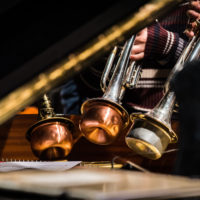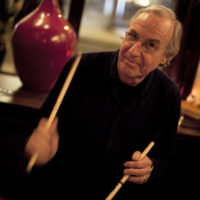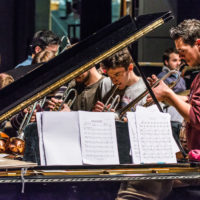The Royal Conservatoire is celebrating a tremendous milestone this year: forty years of jazz education.
There have been plenty of changes in that time, but also a lot that has remained the same. Here is a brief overview of what has already been accomplished, and a look ahead to what has still to come in the future.

In the beginning
The Royal Conservatoire moved into the magnificent new building at Juliana van Stolberglaan 1 in The Hague at the end of the 1970s. Its mission: to train students of opera, ballet and classical music to the highest standard with the very best teachers. At the last moment, the school’s director, Jan van Vlijmen, decided that there should also be a jazz programme.
Some of The Hague’s top jazz musicians joined the staff from the very beginning: pianist Frans Elsen, trumpet player Ack van Rooijen and guitarist Peter Nieuwerf. They invited some of their professional colleagues to join them as teachers: Ruud Brink and Ferdinand Povel for saxophone; Bart van Lier for trombone; Clarence Beckton for drums and John Clayton for double bass. Frans Elsen and Boudewijn Leeuwenberg taught music theory, while the jazz writer, critic and historian Ruud Kuijper taught a course in the history of jazz.
It was a very intimate affair during that first decade. Most of the first cohort of students were members of The Hague Big Band, which already existed before the jazz department opened its doors, and they brought with them the big band’s professional, critical, friendly and perfectionist approach. That outlook has remained a constant factor in the jazz department right up until today.
At the beginning of the 1980s, there was criticism of jazz programmes in the music press. The clichés the criticasters used ring false today: jazz can’t be taught; jazz programmes merely produce clones of deceased jazz giants; jazz is learned on the street, not in school. Within just a few years it became clear that the jazz programmes were producing a refreshing new generation of young jazz musicians who were providing new impulses for the global jazz world. For example, even before the members had graduated from the Conservatoire, the Ben van den Dungen Jarmo Hoogendijk Quintet was constantly touring throughout Europe and selling large numbers of CDs.
The Hague Big Band, which is now the Royal Conservatoire Big Band, went public in the mid-1980s with a vinyl LP featuring only arrangements by Dutch composers and arrangers. The band made its first successful appearance at the North Sea Jazz Festival where, conducted by Frans Elsen, it performed a programme made up entirely of the band’s own work. This was followed a year later by an equally successful appearance in the PWA hall, the largest venue at the festival, conducted by the American arranger-composer Bob Brookmeyer. In the ensuing years the Royal Conservatoire Big Band has been a regular guest at the North Sea Jazz Festival with guest conductors including Bill Holman, Bob Mitzer, Maria Schneider, Lalo Schifrin, Rob Pronk and Rob McConnell.

Growth
The programme’s second decade was characterised by growth and internationalisation. The small, intimate jazz department with Dutch-speaking students expanded. Classes were now taught in English. Jazz was growing internationally and the Royal Conservatoire’s jazz department grew with it. The Dutch students initially had to acclimatise to studying with colleagues from Denmark, Germany, Spain, Italy and Korea, but multinational lessons, classes and combos quickly became the norm, as they were in jazz education worldwide.
The programme steadily acquired its own unique identity during the second decade. By the 1990s, the teachers in the department were publishing books on jazz theory and practice. The Royal Conservatoire’s jazz department’s reputation as an international, but above all European institute of education, was growing all the time. The Dutch teachers were joined by colleagues from the US, including Jeanne Lee, Rachel Gould and John Ruocco, but also Dutch greats such as Eef Albers, Jarmo Hoogendijk, Rob van Bavel and Eric Ineke.

A new generation
Around the turn of the century, the jazz department’s student population stabilised at around a hundred. But as the programme entered its third decade, the teachers who had been there from day one began retiring. These founding fathers of the jazz department had themselves not been trained in jazz, but in classical music. Their pioneering work was taken over by a younger generation who did have a jazz education.
In the meantime, conservatories worldwide were evolving into universities of music. In the process, far greater emphasis was being placed on research, particularly in Master’s programmes. For the jazz department, this meant that practice-oriented research assumed a new and prominent role in the curriculum during the fourth decade of its history. The final presentations of the research conducted by the jazz students receive above-average grades from international panels.
Nor is the practical research confined to the students. Teachers are given the opportunity to combine their work with research for a dissertation to earn a Master’s degree.
Changes in the student and teaching population, expansion and deepening of the curriculum and a constantly changing performance practice. A lot has changed through the decades, but a lot has also remained the same. The fellowship between students and teachers is embedded in the DNA of the jazz programme: students are the future colleagues of the teachers, who all have deep roots in professional practice. Outside the school, students and teachers frequently meet up to perform together at the numerous jam sessions and concerts in The Hague.

Key to the future
Looking back, the history of 40 years of jazz education at the Royal Conservatoire has been quite turbulent. The original teachers were succeeded by a new generation with a thorough grounding in the teaching of jazz. Today’s students are the outstanding performers, dedicated teachers and thorough researchers of the future.
The key to the future is undoubtedly the use of new teaching methods and new curricula, in which digital media will play an important role. In the current era, there is no limit to the information that is available, when and where you need it. Today’s students want to learn from their teachers how they can forge a path through the mass of information coming at them from every direction. The Royal Conservatoire’s jazz department was originally a place where you could find whatever information you needed about jazz. No longer. Today, the jazz department is a place where tomorrow’s professional jazz musicians can find the information they need to develop fully as individuals.
In the not too distant future the department will be moving to a new building with even better facilities than at present. It is the start of a new era and a perfect moment to reflect on past achievements and the foundations for future progress that have been laid during the last four decades.